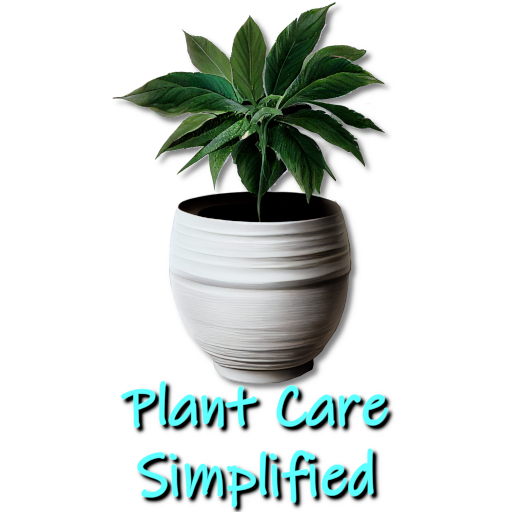What Is LECA for Plants, and Why Is It Useful?
Kim is passionate about helping people create beautiful, healthy indoor spaces that are filled with plants. Kim believes that plants make us happier, healthier human...
- LECA is an acronym for lightweight expanded clay aggregate
- It is used as an alternative growing medium for indoor plants
- Its structural nature gives it many advantages over dirt-based media
- LECA balls are reusable and environmentally friendly
- It requires proper preparation before use and can occasionally be hard to clean for reuse
LECA balls for plants are an alternative soilless growing medium you can use to cultivate plants in full hydroponic systems, using passive hydroponics (semi-hydroponics), or combined with other growing media. These pieces of clay aggregate can take the shape of balls, pellets, or pebbles, are easily obtainable, and have become increasingly popular over the last thirty years or so.
Using LECA balls offers many advantages over dirt-based growing mediums regarding plant maintenance, plant growth, and environmental benefits. There are some drawbacks as well, particularly in terms of preparation.
We will discuss both the advantages and drawbacks and the contexts in which these can apply.
What Is LECA for Plants?
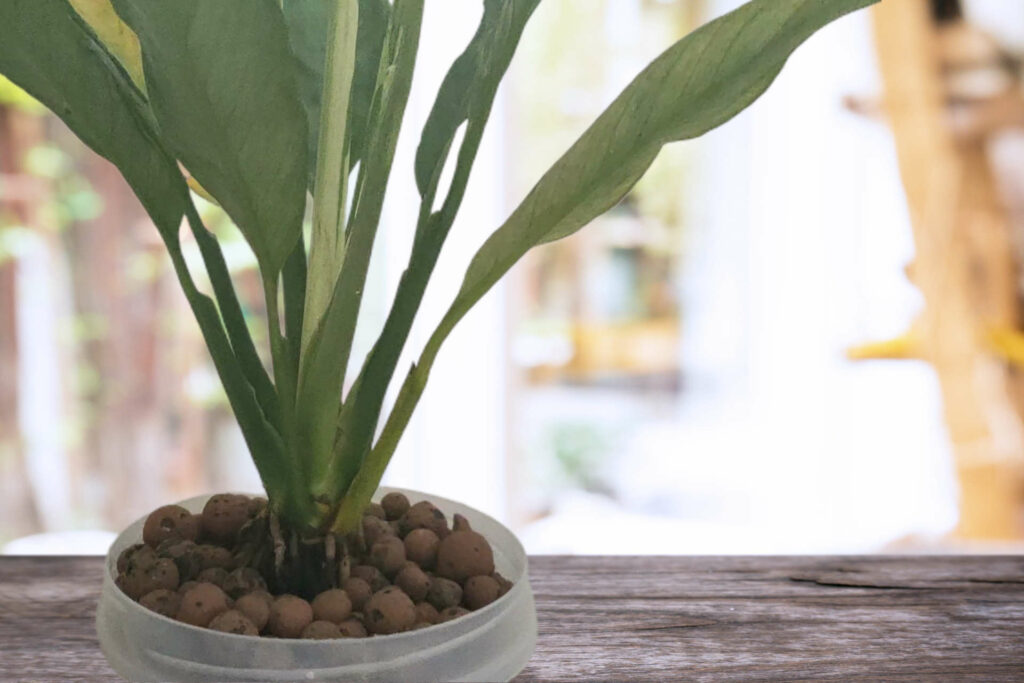
LECA is an acronym for lightweight expanded clay aggregate. The expanded clay pebbles take the form of irregular spheres. Usually natural in color, they come in multiple different diameters.
The Difference Between LECA Balls and Hydroton™ Pebbles
LECA balls can sometimes be referred to as Hydroton™ Pebbles. Hydroton™ is a trademark, and it was registered in December 2014. The filing describes the trademark in the following terms:
"expanded clay for hydroponic plant growing" - First use: 20140506. first use in commerce: 201405061
Effectively they are the same thing, lightweight expanded clay aggregate. If you hear a reference or buy Hydroton™, you are talking about or buying a branded LECA.
What Are LECA Balls Made Of?
LECA consists of coarse clay formed into balls/pebbles and fast-fired at around 2,200°F (1,100 °C). The firing process dissipates the gas from internal air bubbles inside the pre-fired clay balls, leaving a honeycomb of tiny holes and making the LECA porous.
What Size are LECA Balls
LECA balls have various uses other than as a growing medium, and you can find a whole range of sizes. The size of the LECA varies greatly depending on the application's specific needs.
LECA balls for plants are generally sized between 0.3″ to 0.8″ in diameter. For some ornamental and exterior plant uses you can find sizes up to 1.2″ (30mm).
Properties of LECA Pebbles as A Growing Medium
| Property | Value | Notes |
|---|---|---|
| Water Holding Capacity (WHC) | Low | Expanded clay aggregate has a limited water-holding capacity |
| Aeration Propensity (AFP) | High | Expanded clay aggregate has a high air-filled porosity (AFP) |
| Nutrient Delivery | None | In terms of cation exchange capacity, LECA particles exhibited a low level of performance. CEC of 0.82 me/100 g Ca and 6.36 me/100 g K |
| Pest Control | High | Prevents fungus gnats from laying eggs |
| Recyclability | Yes | Can be continually reused |
History of Lightweight Expanded Clay Aggregate
The development of lightweight expanded clay aggregate was originally for use in shipbuilding in 1917. The material, then known as Haydite, was used in the building of the SS Selma, one of a series of concrete vessels that were trialed at the time. The strength and lightweight nature of the Haydite made it an ideal component of the ferrocement construction of these concrete ships.
Although the government quickly abandoned the concept of concrete vessels, the expanded clay aggregate product found other uses in construction environments.
LECA’s structural nature presented itself as an ideal substrate for the soilless cultivation of plants. The rise of hydroponics and the use of soilless-based growing environments saw expanded clay pebbles become established as an alternative growing medium for plants.
Over the last thirty years, its popularity has risen sharply as gardeners and plant owners saw the numerous advantages of using LECA over dirt-based mediums, especially in indoor growing environments.
Expanded Clay Pebbles Offer Several Advantages
The main benefit of using LECA balls is that they offer a better environment for root development than other materials, such as gravel or lava rock. The main drawbacks of using LECA balls include cost and availability.
- They do not release any nutrients into the water stream, and their neutral pH averages 7.0 over time.
- They are relatively porous, giving them good drainage properties.
- Suitable for aeration, helping prevent root rot.
- Their honeycomb structure will enable them to absorb water for short periods and help manage humidity around the plant.
- They are environmentally friendly since they can be cleaned and reused.
- They are durable and will last for many years.
The Advantages of LECA's Porous Structure
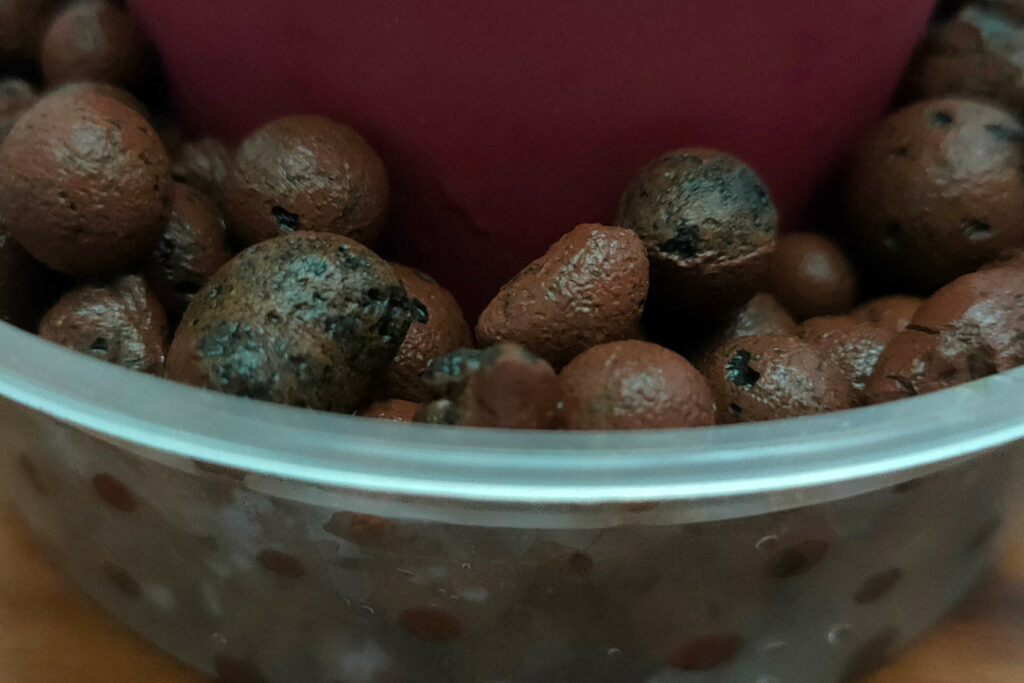
Clay pellets are an ideal growing medium for plants because they have high porosity, making it easy for water to pass through them. The pores in clay pellets allow water and dissolved nutrients to pass through the material very quickly, so they don't block the flow of the solution like some other types of media might.
In addition, the porous nature and the gaps that sit between them allow for good aeration. The increased aeration offers a better environment for root development than other materials, such as gravel or lava rock, and helps prevent root rot.
The porous structure makes them suitable for various types of growing systems. These include ebb and flow systems, where water needs to drain out and then return to the reservoir, aquaponic media bed systems, and semi-hydroponics, such as use with individual plants.
The porosity of clay aggregate also improves drainage. This property can be significant if used as a soil amendment in the garden to enhance the quality and structure of the soil.
LECA Clay Pebbles Are a pH Neutral Growing Medium
LECA balls don't release any nutrients into the water stream that might cause problems with algae growth or other nutrient problems in your system. In addition, they are also neutral with a pH of about 7.0, enabling use in any aquaponic system without causing problems with pH balance or other issues like that.
Managing Humidity
Many indoor plants are native to tropical conditions and are used to and expect a specific humidity level to grow at their best. Because LECA can quickly absorb water but cannot retain it for long periods, it can help create humidity around a plant by releasing moisture from the clay aggregate. The moisture released can increase the humidity levels around the plant from 40% to between 60 and 80%.
Environmental Benefits of LECA
After use, clay pellets can be washed and sterilized for reuse (be sure not to contaminate any other parts of your system). They are also incredibly durable – many growers report using them for years without needing replacement!
In addition, it can replace growing media such as peat moss, a protected material in some parts of the world, because of the environmental damage caused by its removal.
LECA Balls Can Help Prevent Pests
Insects such as aphids and fungus gnats that can plague plants are attracted to damp soil. They lay their larvae and feed on a plant's roots, causing damage to the plant's ability to grow properly. Indoor plants are particularly susceptible to the problem of pests as overwatered plants tend not only to attract more pests but also lessen their ability to fight them off.
LECA balls help alleviate the issue. When used solely as a soilless medium, there is no damp soil to attract the insects and thus preventing insects from laying their eggs there and potentially damaging your plant.
The LECA balls are cleaner and more attractive than the alternatives.
The main benefits of LECA balls compared to other growing media is that they are cleaner and aesthetically pleasing. They also allow the use of transparent containers, which makes it all the easier to keep an eye on your plants
Cleanliness of the process and clay aggregate allow transparent containers for growth monitoring purposes. You can also see how much light your plant needs, with each container being clear glass which lets you see exactly where your plants are at any given time during growth stages.
LECA creates an aesthetically pleasing look, depending on your tastes. It becomes part of the 'effect', and the type of container you use and the color scheme you want will determine whether you choose natural or colored clay aggregate.
The Main Drawbacks of Using LECA Balls
- Preparation required: LECA balls need proper preparation before use.
- LECA balls do not have a good water-holding capability compared with other growing media.
- Although almost infinitely reusable, the initial cost can be higher than other growing media.
- LECA has little nutrient value. The solution you use to water your plant should include nutrient supplements
- Plant roots can bind tightly around the balls, sometimes making them difficult to remove.
Preparation Required
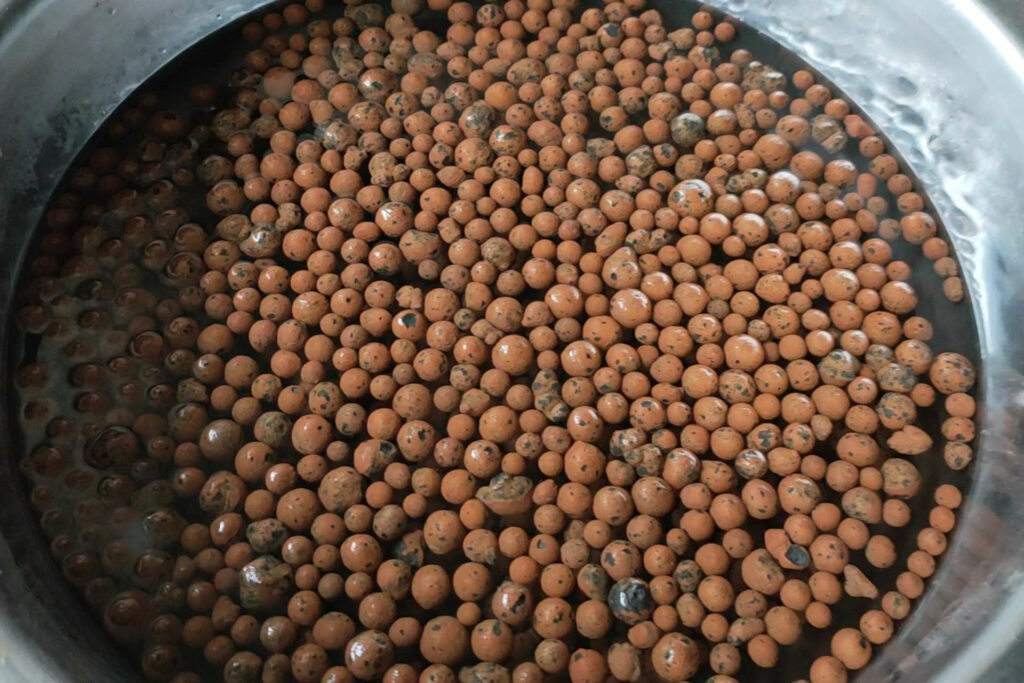
The biggest drawback of using or reusing LECA is the preparation required. When jostled together, they can create a considerable amount of clay dust. The clay dust can contaminate the nutrient solution, and you must clean it before use.
Because of their nature, depending on the quality of the LECA balls, preparing them to be ready for use can be an involved task. There are multiple stages, including washing, rinsing, and boiling, before being left to soak for between 24 to 48 hours.
No Nutrients Present
There are virtually no nutrient benefits for plants from LECA as a growing medium. In addition, it performs poorly in terms of cation exchange capacity; LECA particles exhibited a low level of performance. CEC of 0.82 me/100 g Ca (Calcium) and 6.36 me/100 g K (Potassium).
Nutrient delivery is provided via the solution in the hydroponic system. The solution needs monitoring to ensure the required levels of nutrients are present. The nutrient levels required varies with the type of plant. With semi-hydroponics and indoor plants growing in a domestic environment, the monitoring will probably be minimal.
LECA's Limited Water Retention Capacity
Although the high air-filled porosity (AFP) provides an advantage in terms of the aeration of the water, its porosity is also a disadvantage. Expanded clay aggregate has limited water-retention capacity compared to other soilless growing media. Although its porous structure allows it to absorb water, it dries out quickly.
Interestingly, tests have shown that smaller LECA balls (4-8mm) hold more water than the larger aggregate (12-18mm).2
Despite clay aggregate's ability to absorb water, the lack of water retention can cause plant roots to dry out as the balls quickly drain and lose all moisture. You should therefore ensure that the plant's roots have adequate contact with the water if using a semi-hydroponic system. This will ensure that the roots' capillary action to draw on the water/ nutrient solution can work effectively.
Cost of LECA Compared to Other Growing Media
LECA balls cost more than growing mediums like coco coir or perlite, but they also last longer and require less maintenance once they've been used multiple times over time (as long as they're not exposed directly outdoors). If money isn't an issue for you, then this may be a good option for growing indoor plants!
Plant Roots Can Bind to the LECA Balls
The small gaps between the clay balls can cause the roots of plants to curve around the balls and, in some cases, even adhere to them. This is less of an issue for single plants but can cause problems in hydroponics, especially if using the Dutch Bucket system.
Where to Buy LECA Balls?
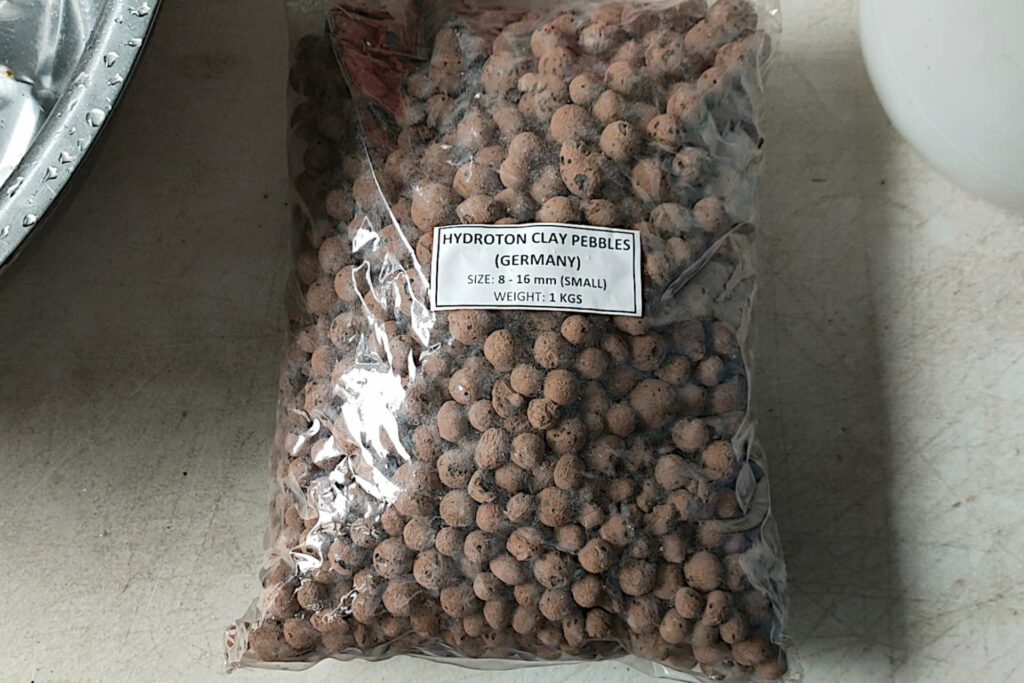
Because of the rise in popularity, LECA is easy to get hold of. Most good garden centers, plant nurseries, and even some hardware shops will stock LECA balls for plants. They are also available online from garden store sites or general sites like Amazon.
Best LECA for Plants - What to Look out For?
As with almost everything you buy, quality can vary. Better quality clay balls tend to be more uniform in size and are likely to produce less dust when jostled together, speeding up the preparation process.
Opinion
We consider LECA one of the best soilless growing mediums available. They provide an excellent structural base for plants, reduce the problem of pests, allow you to see the root structure as your plant grows, and are aesthetically pleasing.
Pretty much any plant can be grown in LECA, although those requiring few nutrients are often the best plants with which to use LECA.
The drawbacks are relatively easy to overcome, and the more significant issues come with how you can use LECA balls. There are particular problems with mixing clay pebbles with soil; they work best as an alternative to soil.
References
- United States Patent and Trademark Office: Serial No. 86273542 Reg. No. 4652890 - HYDROTON TSDR Status: LIVE https://tmsearch.uspto.gov/
- Mana Libran and David J. Williams, HortScience: Characterization of Leca Clay Pebbles as a Growing Medium for Geranium (Pelargonium hortorum) Stock Plant Production
Kim is passionate about helping people create beautiful, healthy indoor spaces that are filled with plants. Kim believes that plants make us happier, healthier human beings, and she loves sharing her knowledge with others so they can experience the joys of plant care for themselves. <a href="https://plantcaresimplified.com/kim-marson/">Read more</a>
More Posts